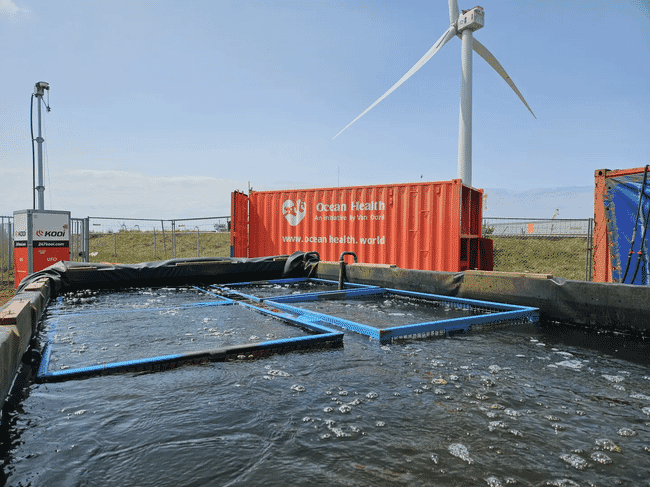
© Van Oord Ocean Health
This pilot project brings together Dutch marine contractor Van Oord, alongside companies, research institutions and nature organisations, in a unique effort to restore oyster reefs in the North Sea on a large scale. It is trialling a new method that combines nature restoration with the installation of marine infrastructure such as wind turbines, breakwaters and subsea cables – with foundations coated in juvenile oysters before being placed at sea.
The new remote “setting method”, involves cultivating millions of oyster larvae in a dedicated hatchery before transferring them to a harbour or other location close to the sea. There, they are placed in shipping containers filled with seawater and rocks. In just a few days, the larvae attach themselves to the rocks and then grow into juveniles. The consortium is also exploring whether reef sounds help flat oysters locate suitable habitat, and whether those sounds could be used to boost their chances of settling.
Rocks with oysters
After a few weeks, the oyster-covered rocks are deployed at sea, where they can form new reefs. If successful, this modular, flexible method could offer a cost-efficient approach to reef restoration that integrates directly into offshore infrastructure such as wind farms, subsea cables and breakwaters. Researchers will monitor the oysters’ survival and growth over the coming months, with another trial planned next year at a TenneT cable crossing in open sea.
“Thanks to close collaboration, our consortium has been able to deliver and implement a major innovation. I’m extremely proud of that. It holds promise for scaling up nature restoration in the North Sea and may have a significant positive impact in years to come,” said Nienke Oostenbrink, pilot lead and business developer for Van Oord Ocean Health, in a press release.
Oyster reefs
The drive to develop this new method stems from growing concern over marine life in the North Sea. Oyster reefs – once widespread – have almost vanished due to overfishing, pollution and disease. These reefs are vital ecosystems: oysters cluster to form hard, complex structures that shelter marine plants and animals, while also filtering water, recycling nutrients and absorbing waste. By restoring them, the remote setting method could play a crucial role in bringing life back to the North Sea.
“Oysters are the silent engineers of a healthy aquatic ecosystem. Restoring the reefs is no luxury, it’s a necessity. I am hopeful that we can restore the reefs using this innovation,” said Vera Bánki, De Rijke Noordzee programme director.
Unique partnership
The project draws on the expertise of the nine consortium partners: Wageningen Marine Research, Wageningen University & Research, ARK Rewilding Nederland, Stichting Zeeschelp, Waardenburg Ecology, Van Oord Ocean Health, TenneT, Port of Rotterdam Authority and De Rijke Noordzee (a joint venture between Dutch nature conservation organisations Stichting de Noordzee and Natuur & Milieu). The consortium has spent the past 3 years working together to refine the remote setting method.



